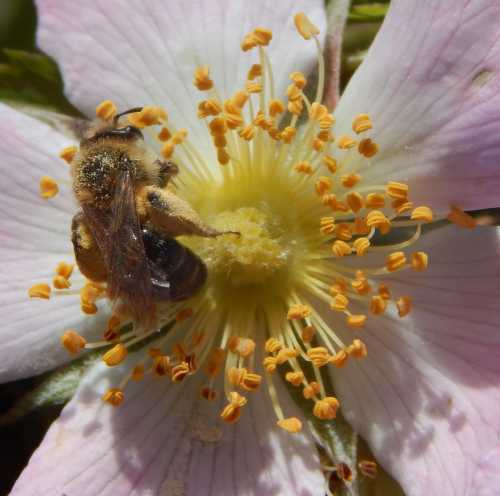Is A Bee An Insect?
What Is A Bee?
Updated: October 2023
Is a bee an insect? ... and other questions....
What is a bee exactly?
- Is a bee an insect or a bug, and how do insects and bugs differ from each other?
- Are bees a type of fly or even a type of wasp?
- Are bees invertebrates?
- Do bees belong to the animal kingdom?
- Given that bees are furry, are they also mammals?
These are fair questions from anyone wishing to learn all about bees.
Firstly, the short answers are as follows:
Q. Is a bee an insect?
A. Yes. Bees share insect characteristics including having 2 pairs of wings and 6 legs. More detail below.
Q. Is a bee a bug, fly or wasp?
A. No, although both bees, flies, wasps and bugs are insects, flies and bugs share a number of different physical characteristics when compared to bees. Flies and bugs therefore belong to different insect groups.
Wasps are very closely related to bees, and in fact, according to entomologists, bees are a type of hairy wasp! You can read more about this below.
Q. Are bees invertebrates?
A. Yes, bees have no internal backbone and so are invertebrates (members of the animal kingdom that have no backbone).
Q. Is a bee an animal?
A. Yes, in so far as bees are part of the Animal Kingdom along with other invertebrates and vertebrates. Bees have an exoskeleton in common with some (but not all) other members of the animal kingdom.
Q. Are bees mammals?
A. No. Despite having hair, bees are cold-blooded invertebrates that lay eggs. Mammals are always warm-blooded vertebrates that (mostly) give birth to live young.
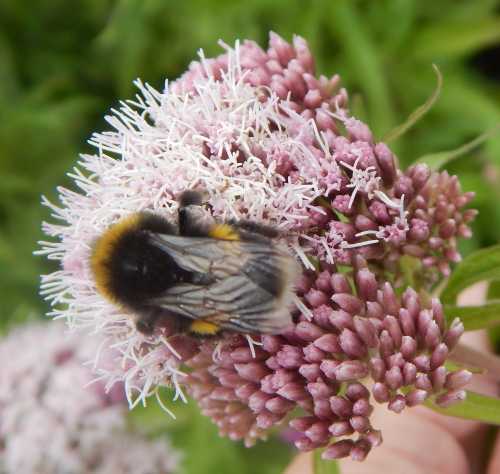 Is a bee an insect? ....and similar questions.
Above: a bumble bee on hemp agrimony.
Is a bee an insect? ....and similar questions.
Above: a bumble bee on hemp agrimony.Read on for a more detailed explanation:
Is a bee an animal?
Yes, bees are animals in that bees, like all invertebrates, are part of the Animal
Kingdom.
To explain further, all living things are classified into groups based on shared characteristics, which are then subdivided multiple times into even smaller groups based on specific types of features that they share in common.
In this way, living organisms from bacteria and fungi to plants and trees, insects, fish, birds, large and small animals, are each put into yet smaller clusters with individual species that are increasingly similar in the physical traits they share.
The first (or top) layer of groups are called ‘kingdoms’ and all living things are further classified from these.
As well as kingdoms for plants, bacteria and fungi, we have the Animal Kingdom, which includes vertebrates and invertebrates.
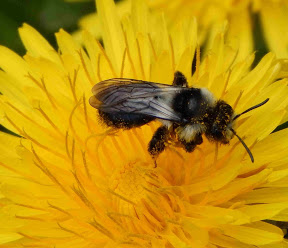 Ashy mining bee foraging on dandelion.
Ashy mining bee foraging on dandelion.Are bees also mammals?
Although
bees have hairs on their bodies as mammals do, and are part of the animal kingdom, bees are
not mammals.
Mammals are warm-blooded vertebrates with mammary glands for feeding milk to their young.
Bees are cold-blooded invertebrates and provision their larvae with food - usually a combination of nectar and pollen.
Warm-blooded: this means they are able to maintain a stable body temperature, whatever the outside temperature.
Cold-blooded: this means their body temperature varies according to the outside temperature.
What Makes A Bee An Insect?
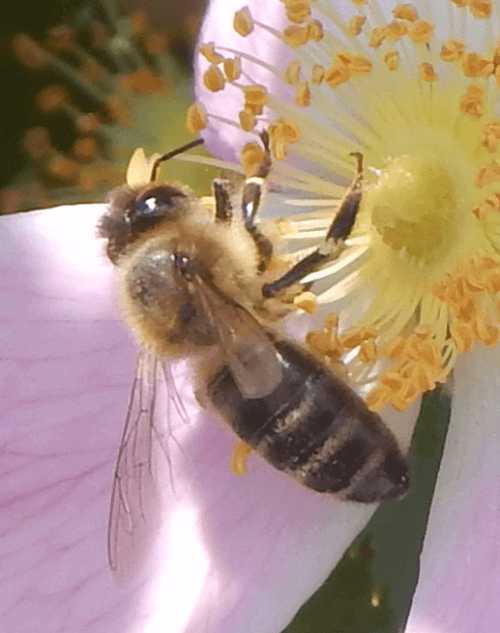
An insect is an invertebrate (animal without an internal backbone), and insects have:
- a pair of antennae,
- a body in 3 parts: head, thorax and abdomen.
- 3 pairs of jointed legs and
- compound eyes.
A bee has all of these features, and is an insect.
You can contrast this with say, a spider, which is not an insect but an arachnid, having 8 legs (4 pairs), no antennae, and 2 body parts (a head and thorax which are merged into one body part, and the abdomen).
Fact:
The scientific study of insects is called 'entomology'.
Entomologists perform a number of very important jobs, from working in tropical medicine to helping with criminal investigations in forensic entomology.
Why is a bee a not bug?
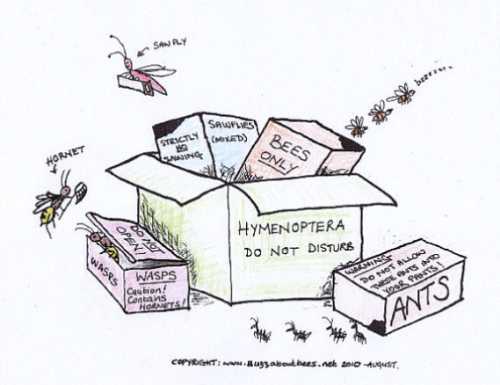 Bees belong to the same insect order as wasps, hornets, sawflies and ants - i.e. Hymenoptera.
Bees belong to the same insect order as wasps, hornets, sawflies and ants - i.e. Hymenoptera.Although a bee is an insect, it is not a bug. Bugs are types of insects, that have piercing mouth parts for sucking juices either from other insects, animals or plants.
Bees belong to the insect order Hymenoptera, whereas bugs belong to the insect order Hemiptera, meaning 'half wing', referring to the fact that part of the first pair of wings in bugs is toughened and hard.
Well known types of Hemiptera include grasshoppers, froghoppers, cicades and water-boatmen.
Bees share the same insect classification (Hymenoptera) with wasps, ants, sawflies and also hornets.
Fact:
It's worth noting that whilst all bugs are insects, not all insects are bugs.
Is a bee a type of fly?
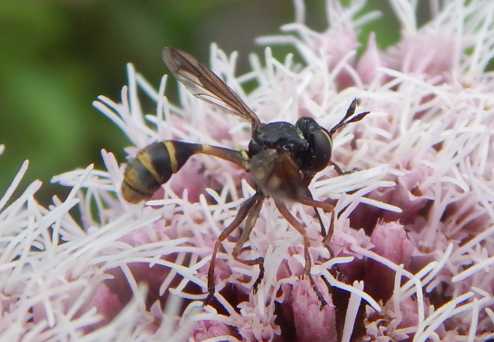 A Conopid fly which is a parasite of bees.
A Conopid fly which is a parasite of bees.No, although bees and flies are insects, flies belong to the insect order Diptera.
Flies have 1 pair of wings (bees have 2 pairs of wings). The mouth parts of flies are for piercing or sucking.
As explained above, bees belong in the insect order Hymenoptera.
Above is a photograph of a conopid fly which is a parasite of bees. In flies, the eyes are typically at the front of the head and are forward-facing. It has one pair of wings and short antennae.
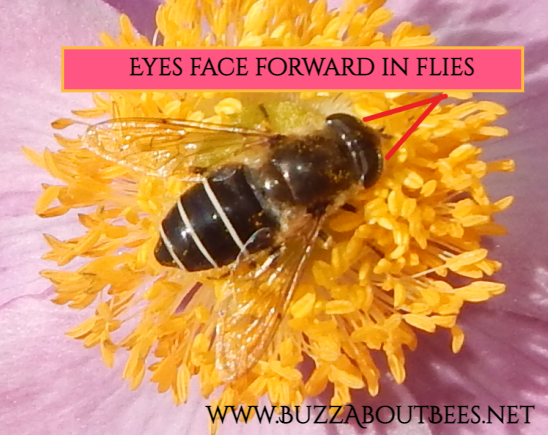
Some flies look a little like bees, as is the case of the bee fly which is actually a parasite of various species, especially of solitary bees. Read about the bee fly.
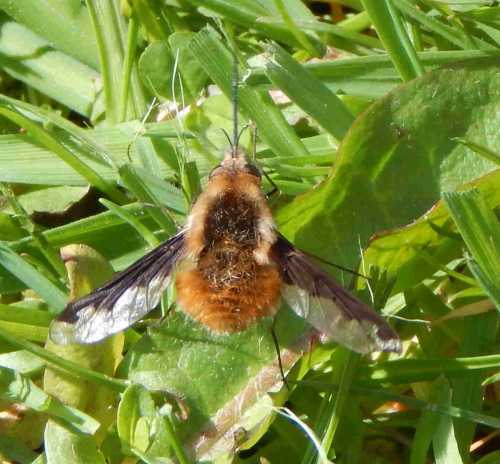 This insect may look like a bee, but it's actually a type of fly.
This insect may look like a bee, but it's actually a type of fly.
In summary....
Bees, true bugs and true flies are all insects, but separate at the classification level of 'Insect Order' - see below:
Bees
Kingdom: Animalia (Animal)
Phylum: Arthropoda (Arthropod)
Class: Insecta (Insect)
Order: Hymenoptera
True Bugs
Kingdom: Animalia (Animal)
Phylum: Arthropoda (Arthropod)
Class: Insecta (Insect)
Order: Hemiptera
True Flies
Kingdom: Animalia (Animal)
Phylum: Arthropoda (Arthropod)
Class: Insecta (Insect)
Order: Diptera
Is a bee a type of wasp?
Bees and wasps are closely related with bees being descended from wasps.
In fact, entomologists such as author of Insectpedia, Eric R. Heaton point out that bees are in fact, hairy wasps.
Bees and wasps belong to the same insect order (Hymenoptera) and sub-order - (Apocrita), however, they are classified differently at the next level of classification, which is Superfamily:
Bee
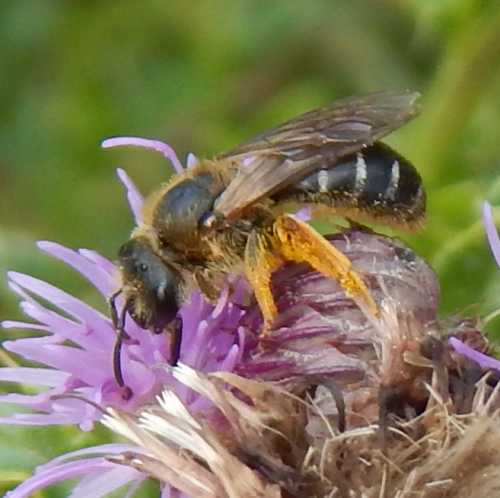
Kingdom:
Animalia (Animal)
Phylum:
Arthropoda (Arthropod)
Class:
Insecta (Insect)
Order:
Hymenoptera
Suborder:
Apocrita
Superfamily:
Apoidea
Wasp
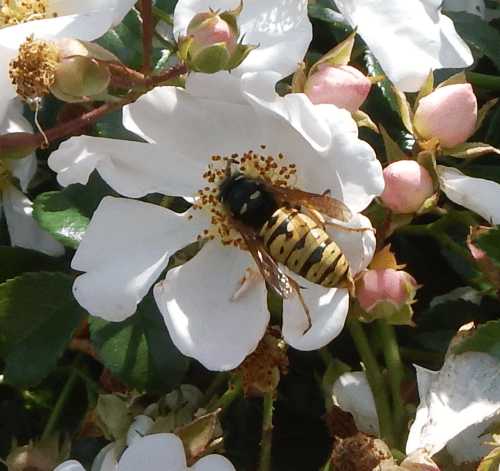
Kingdom:
Animalia
(Animal)
Phylum:
Arthropoda (Arthropod)
Class:
Insecta (Insect)
Order:
Hymenoptera
Suborder:
Apocrita
Superfamily:
Vespoidea
Please note that the term 'meat bee' in some regions of the world actually refers to a wasp, notably yellow jackets.
However, a small number of tropical bee species do in fact eat meat!
More recently, it has been proposed by some scientists that bees are not vegetarian, but are omnivores.
Is A Bee An Invertebrate?
Yes, bees are invertebrates.
As stated, an invertebrate is an animal without an internal backbone (spinal column). Bees have no backbone, only an exoskeleton, which is a thin, shell-like outer skeleton.
Resources
- Bees, Wasps, and Ants: The Indispensable Role of Hymenoptera in Gardens - Eric Grissell.
- Britain's Insects - A Field Guide To The Insects Of Great Britain And Ireland by Paul D Brock
If you found this page helpful or interesting, I'd really be grateful if you would share it with others - if not this page, perhaps another, such as Gardening For Bees.
Thank you so much :) .
